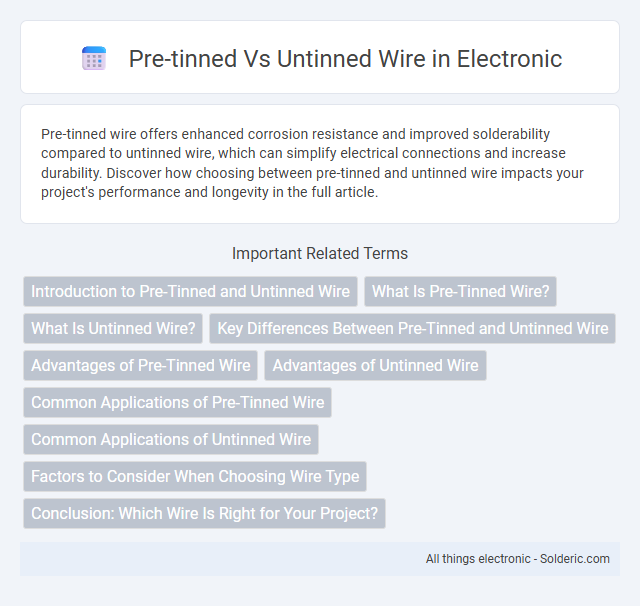Pre-tinned wire offers enhanced corrosion resistance and improved solderability compared to untinned wire, which can simplify electrical connections and increase durability. Discover how choosing between pre-tinned and untinned wire impacts your project's performance and longevity in the full article.
Comparison Table
| Feature | Pre-Tinned Wire | Untinned Wire |
|---|---|---|
| Coating | Coated with a thin layer of tin | No coating, bare copper or metal |
| Corrosion Resistance | High resistance to oxidation and corrosion | Prone to oxidation and corrosion |
| Ease of Soldering | Easier and faster soldering process | Requires more preparation for soldering |
| Application | Ideal for marine, automotive, and humid environments | Common for general electrical wiring where corrosion is minimal |
| Cost | Generally more expensive due to tin coating | Less expensive, raw copper or other metals |
| Durability | Enhanced durability in harsh conditions | Less durable under corrosive environments |
Introduction to Pre-Tinned and Untinned Wire
Pre-tinned wire is copper wire coated with a thin layer of solder to prevent oxidation and improve solderability, making it ideal for electronics and electrical applications. Untinned wire consists of bare copper without any coating, offering higher conductivity but requiring careful handling to avoid corrosion. Choosing between pre-tinned and untinned wire depends on the specific requirements for durability, ease of use, and environmental exposure in a project.
What Is Pre-Tinned Wire?
Pre-tinned wire is copper wire coated with a thin layer of solder, typically a tin-lead or tin alloy, applied during manufacturing to prevent oxidation and improve solderability. This coating enhances electrical conductivity and provides better corrosion resistance compared to untinned wire, making it ideal for electronic and electrical applications requiring reliable, long-lasting connections. Untinned wire lacks this protective solder layer, which can lead to increased oxidation and weaker joints in soldered connections over time.
What Is Untinned Wire?
Untinned wire consists of bare copper strands without a protective layer of tin coating, making it more susceptible to oxidation and corrosion over time. This type of wire is often used in applications where solderability is not a critical factor, or where the wire will be exposed to high temperatures, as the absence of tin enhances its heat resistance. Understanding the properties of untinned wire helps you choose the right material for specific electrical or electronic projects, ensuring optimal performance and durability.
Key Differences Between Pre-Tinned and Untinned Wire
Pre-tinned wire features a coating of solder that prevents oxidation, improving conductivity and simplifying the soldering process, whereas untinned wire lacks this protective layer, making it more susceptible to corrosion and requiring more preparation before soldering. Pre-tinned wire offers enhanced durability and is preferred in applications needing reliable electrical connections and easier maintenance, while untinned wire provides greater flexibility and lower cost but demands extra care to avoid oxidation. The choice between pre-tinned and untinned wire depends on specific project requirements, environmental exposure, and desired ease of use during assembly.
Advantages of Pre-Tinned Wire
Pre-tinned wire offers superior corrosion resistance and enhanced solderability, significantly reducing oxidation during soldering processes. Its pre-applied tin coating ensures better electrical conductivity and stronger, more reliable connections, especially in marine or high-moisture environments. Choosing pre-tinned wire can improve the durability and longevity of your electrical projects by minimizing maintenance and ensuring consistent performance.
Advantages of Untinned Wire
Untinned wire offers superior soldering flexibility, allowing users to apply customized solder types and fluxes for specific applications. It is highly resistant to oxidation, making it ideal for long-term storage and high-temperature environments. Moreover, untinned wire provides better electrical conductivity due to the absence of the tin coating, resulting in improved signal integrity in sensitive electronic circuits.
Common Applications of Pre-Tinned Wire
Pre-tinned wire is commonly used in marine, automotive, and aerospace applications due to its enhanced corrosion resistance and improved solderability, which ensures reliable electrical connections in harsh environments. It is preferred for wiring harnesses, circuit boards, and connectors where long-term durability and oxidation prevention are critical. The tin coating facilitates easier soldering, reducing assembly time and improving joint quality compared to untinned wire.
Common Applications of Untinned Wire
Untinned wire is commonly used in applications where flexibility and soldering adaptability are required, such as in automotive wiring, speaker cables, and homemade electronics projects. Its lack of tin coating allows for easier soldering and rework, especially in prototyping and custom installations. Untinned wire is preferred in environments where direct solderability and cost-effectiveness are prioritized over corrosion resistance.
Factors to Consider When Choosing Wire Type
When selecting between pre-tinned and untinned wire, factors such as corrosion resistance, ease of soldering, and application environment play crucial roles. Pre-tinned wire offers enhanced protection against oxidation, making it ideal for marine or outdoor use, while untinned wire remains flexible and cost-effective for indoor applications. Electrical conductivity, temperature tolerance, and long-term durability must also be evaluated to ensure optimal performance.
Conclusion: Which Wire Is Right for Your Project?
Selecting between pre-tinned and untinned wire depends on project requirements such as corrosion resistance, ease of soldering, and budget constraints. Pre-tinned wire offers superior protection against oxidation and simplifies soldering, making it ideal for electronics and marine applications. Untinned wire can be more cost-effective and sufficient for general wiring tasks where environmental exposure is minimal.
Pre-tinned vs untinned wire Infographic

 solderic.com
solderic.com